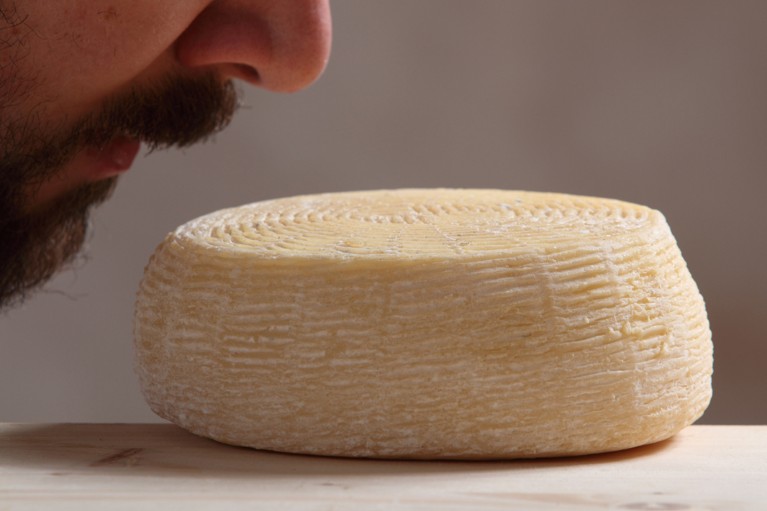The OR51E2 receptor is activated by propionate, which has a cheesy odour.CREDIT: Antonio Nardelli/ EyeEm/ Getty Images
Finding could advance our understanding of how human olfactory proteins recognize specific scents, including the pong of ripe cheese.
It is thanks to proteins in the nose called odour receptors that we find the smell of roses pleasant and that of rotting food foul. But little is known about how these receptors detect molecules and translate them into scents.
Now, for the first time, researchers have mapped the precise 3D structure of a human odour receptor, taking a step forwards in understanding the most enigmatic of our senses.
The study, published in Nature on 15 March1, describes an olfactory receptor called OR51E2 and shows how it ‘recognizes’ the smell of cheese through specific molecular interactions that switch the receptor on.
“It’s basically our first picture of any odour molecule interacting with one of our odour receptors,” says study co-author Aashish Manglik, a pharmaceutical chemist at the University of California, San Francisco.
Smell mystery
The human genome contains genes encoding 400 olfactory receptors that can detect many odours. Mammalian odour-receptor genes were first discovered in rats by molecular biologist Richard Axel and biologist Linda Buck in 19912. Researchers in the 1920s estimated that the human nose could discern around 10,000 smells3, but a 2014 study suggests that we can distinguish more than one trillion scents4.
Each olfactory receptor can interact with only a subset of smelly molecules called odorants — and a single odorant can activate multiple receptors. It is “like hitting a chord on a piano”, says Manglik. “Instead of hitting a single note, it’s a combination of keys that are hit that gives rise to the perception of a distinct odour.”
Beyond this, little is known about exactly how olfactory receptors recognize specific odorants and encode different smells in the brain.
Technical challenges in producing mammalian olfactory-receptor proteins using standard laboratory methods have made it difficult to study how these receptors bind to odorants.
“Almost all of them really don’t like being in any other kind of cell other than an olfactory sensory neuron,” says Matthew Grubb, a neuroscientist at King’s College London. This means that they cannot be grown or stabilized in commonly used cell lines. “You would have to dissect probably thousands of mice noses” to replicate samples, says Grubb. “It’s just not feasible.”
To overcome this, Manglik and his colleagues focused on the OR51E2 receptor, which has functions beyond odorant recognition and is found in gut, kidney and prostate tissues, as well as olfactory neurons.
Vinegar and cheese
OR51E2 interacts with two odorant molecules: acetate, which smells like vinegar, and propionate, which has a cheesy odour.
The authors purified the receptor and analysed the structure of propionate-bound and unbound OR51E2 using cryo-electron microscopy, an atomic-resolution imaging technique. They also used computer-aided simulations to model how the protein interacts with the odorant at an atomic scale.
They found that propionate binds OR51E2 through specific ionic and hydrogen bonds that anchor the propionate’s carboxylic acid to an amino acid, arginine, in a region of the receptor called the binding pocket. Binding to propionate alters the shape of OR51E2, which is what turns the receptor on.
These molecular interactions are crucial: the researchers showed that mutations affecting arginine prevented OR51E2 from being activated by propionate.
“This is our way of kind of lining up the dominoes to understand how pushing on one side of the receptor turns the other side on,” says Manglik.
On the scent
Scientists have long dreamed of building a molecular atlas of olfactory receptors that maps their chemical structures and which combinations of receptors correspond to particular odours. But “that’s been very much out of reach for the field”, says Manglik.
The OR51E2 receptor is specific to propionate and acetate. But “it’s not all about single odorant binding to single receptor molecules”, says Grubb. OR51E2 is a class I olfactory receptor; only around 10% of human olfactory-receptor genes encode this type. The rest code for class II receptors, which typically recognize a broader range of odours. “They may have very different mechanisms,” says Vanessa Ruta, a neuroscientist at the Rockefeller University in New York City.
Studying other examples of human odour receptors and elucidating their structures is crucial, she adds. “It will allow for a broader understanding of the different ways that odorants are recognized.”
doi: https://doi.org/10.1038/d41586-023-00818-3
References
-
Billesbølle, C. B. et al. Nature https://doi.org/10.1038/s41586-023-05798-y (2023).
-
Buck, L. & Axel, R. Cell 65, 175–187 (1991).
-
Crocker, E. C. & Henderson, L. F. Analysis and Classification of Odors: An Effort to Develop a Workable Method (Robbins Perfumer Company, 1927).
-
Bushdid, C. et al. Science 343, 1370–1372 (2014).
Source: How do we smell? First 3D structure of human odour receptor offers clues













